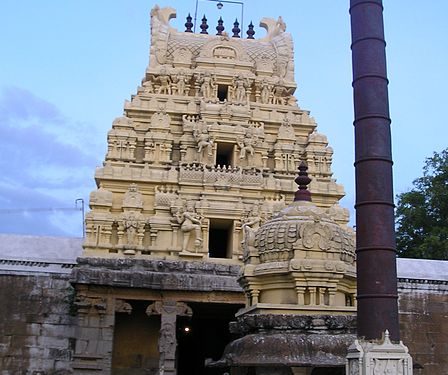Shiva is worshipped as Sathyanatheswarar and his consort Parvathi as Pramarambikai. Sathyanatheswarar is revered in the 7th century Tamil Saiva canonical work, the Tevaram, written by Tamil saint poets known as the nayanars and classified as Paadal Petra Sthalam, the 275 temples revered in the canon.

Legends Associated with This Shrine
According to legend, Indra, the king of celestial deities and Bhudan (Venus) worshipped Shiva at this place located in a forest called Kaaraivanam. Since it was located in Kaaraivanam, the presiding deity came to be known as Karaivananathar . Tirugnana Sambandar, a 7th-century Tamil Saivite poet, venerated Sathyanatheswarar in one verse in Tevaram, compiled as the First Tirumurai. As the temple is revered in Tevaram, it is classified as Paadal Petra Sthalam, one of the 275 temples that find mention in the Saiva canon. As per Hindu legend, Chandra (moon) was under the tutelage of Guru (Jupiter). He wanted to marry Guru’s wife, Dhara and did a yagna seeking the boon from Vishnu. Guru attended the function with Dhara when she was allured by Chandra. Budha was born to Chandra and Dhara. When Budha became a youngster, he came to know about his birth, felt ashamed and started doing a penance praying to Shiva to include him as one of the Navagrahas at this place. Shiva was pleased by his devotion and appeared as Sathyanatheswarar to offer him the boon. As per another legend, Indra, the king of Devas, the celestial deities, was attracted by the beauty of Ahalya, the wife of sage Gautama. He took the form of a rooster to wake the sage early in the day. The sage started his day by going to the river, leaving Ahalya alone in the house. Indra entered the house to attain Ahalya, but the sage sensed something was wrong in the day. He returned to the hermitage and saw Indra escaping as a cat. He cursed Indra to have eyes throughout his body. Indra was roaming around and started doing penance at this place to regain his appearance.
Architectural Relevance of This Shrine
The temple is located in the Thirukalimedu locality in Kanchipuram. The temple covers an area of 22,500 sq ft (2,090 m2). Sathyanatheswarar temple complex has two prakarams , a lotus tank and a three-tiered raja gopuram raising to a height of 50 ft (15 m) facing West. The central shrine faces east and holds the image of Sathyanatheswarar (Shiva) in the form of lingam made of granite and is believed to be a swayambumoorthy . As in other temples in Kanchipuram, there is no separate shrine of Parvathi as it is believed that Kamakshi of Kanchipuram is the common Parvathi shrine for all Shiva temples. There is a shrine facing South where the festival image of Pramarambikai is housed. All the rituals performed for the deity is similar to the ones done for the presiding deity. The granite images of Nandi, a tall flagstaff and a Balipeeta, the place of offering, axial to the sanctum. As in other Shiva temples of Tamil Nadu,the first precinct or the walls around the sanctum of Sathyanatheswarar has images of Dakshinamurthy , Durga (warrior-goddess) and Chandikeswarar (a saint and devotee of Shiva). The temple precinct is surrounded by granite walls. Based on the historical significance of the temple, it was in the proposal of Archaeological Survey of India, Chennai Circle, as one of the seven temples to be included as an archaeological monument.
Shrine’s Map Location and How to Go There
By Road
From Kanchipuram, there are many auto-rickshaws that drive you to the temple. Kanchipuram is well connected by several bus services from Chennai and other places in Tamil Nadu.
By Rail
Located a km away from Kanchipuram Railway Station. From Kanchipuram Railway Station private taxis are available to reach this temple. Kanchipuram rail-line is connected to Chennai, Pondicherry, Nagaercoil and Madurai.
By Air
Chennai is the nearest airport. From Chennai, the temple in Kanchipuram is 75 km away.
Shrine Timings
7.00 a.m. to 1.00 p.m. and from 4.00 p.m. to 7.00 p.m.
Events Celebrated at This Shrine
Margazhi Tiruvadhirai in December-January, Mahasivarathri in February-March and Aipasi Annabishekam in October-November are the festivals celebrated in the temple.













































